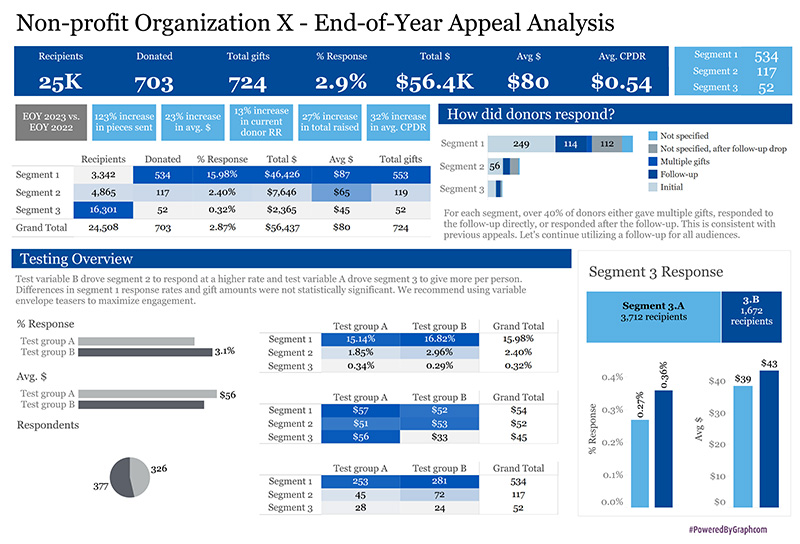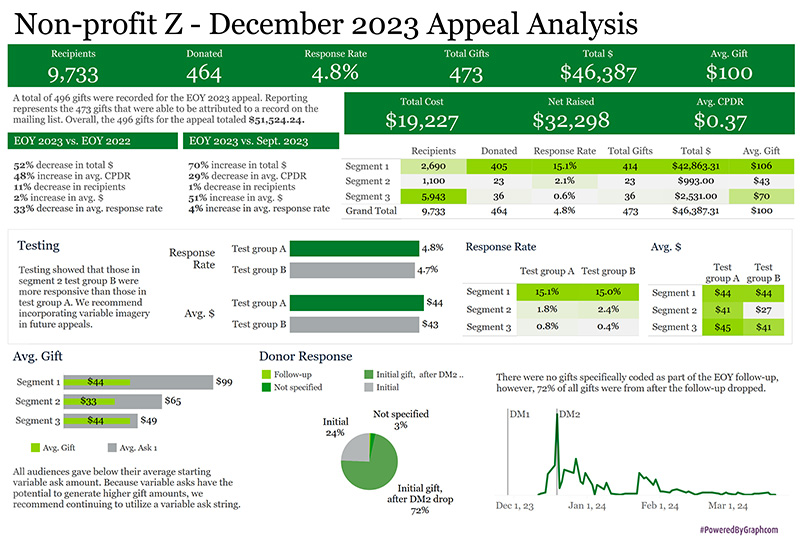The Power of Donor Data: Enhancing Nonprofit Impact
Leveraging Data for Fundraising Success
Nonprofits know the importance of gathering data on their donors and campaigns. However, you need to leverage the power of donor data to boost fundraising results and drive effective outreach and appeal strategies. To start the process, let’s organize fundraising metrics into three overarching categories based on what they describe and how they’re used:
- Descriptive Analytics describes, summarizes, and demonstrates key data points to help nonprofits understand their current performance at the individual, campaign-specific, and organization-wide levels.
- Diagnostic Analytics examines data to understand the root causes of events, behaviors, and outcomes, identifying what went well or where you fell short so that you can adapt as needed.
- Predictive Analytics forecasts future outcomes by comparing performance metrics over time to make logical inferences about how trends are likely to continue. Nonprofits regularly use AI software to generate expanded, individualized predictive insights.
Planning and Evaluating Campaigns
As you plan a new email campaign or strategize your upcoming direct mail appeal, it’s essential to start by studying how your last campaign performed. If you aim to raise more money, data analytics can help you evaluate factors like retention rates and your donors’ giving lifecycles.
Segmenting donors by interests, lifestyle, and channel preferences allows you to create more personalized, targeted appeals, which can lead to increased donations from your audience. Segmenting donors by shared characteristics can also help you target your most valuable donors more effectively. According to a study conducted by Mailchimp, compared with non-segmented emails, personalized and segmented emails received approximately 101% more clicks.
Collecting and Managing Donor Data
Any time donors engage with your nonprofit’s fundraising strategies, whether through donating on your website, newsletter, or donor management software, it provides an opportunity to collect data. Using a dedicated customer relationship management (CRM) platform or database, nonprofits can easily track these interactions and study how effectively fundraising and outreach tactics perform. CRMs reduce manual entry, provide instant access to reports, and allow you to configure incoming data to be tagged with appropriate features like:
- Donor name
- Date
- Amount
- Campaign/source of donation
- Average gift size
- Gift recency
- Gift frequency
- Donor lifetime value
- And other predictive markers
Utilizing Data Insights
Data analytics for nonprofits involves uncovering insights to understand the data. Describing the number of donations received for a specific campaign or providing details about your donor demographics offers valuable insights into your organization’s current status.
Use key performance indicators (KPIs) to help predict upcoming trends by combining current and historical data. KPIs can prescribe the best course of action for your organization so you can be more effective and help you understand what kind of story each donor will connect with (by tracking keywords on your website, for example).
Building Strong Donor Relationships
Relationship building is the heart of fundraising, after all! Data can’t give you more time, but it can help you get to know your donors better so that you can be more productive in your interactions and strengthen your relationship with each one.
Storytelling is a powerful tool you can use in your communications to connect donors with your cause and organization. In fact, studies have shown that nonprofits effectively using storytelling in their fundraising efforts have a donor retention rate of 45%, compared to 27% for organizations that do not focus on storytelling.
By incorporating key insights into your stories and narratives, data can help you assess the impact of your nonprofit’s stories and gain a better understanding of your organization’s effectiveness.
Strategic Decision-Making
When it comes to overall strategy, data-based decisions can help avoid costly mistakes, such as sending appeal letters to unresponsive donors. Constituent data enables you to determine how much to ask for, when to make your request, and which communication channel to use.
Understanding the motivations behind donor giving and what they appreciate most about your organization enables you to tailor your outreach to specific donor groups. This involves segmenting donors based on factors such as donation amount, key behaviors, and demographic information and then directing personalized communications to each group.
Ensuring Data Quality
Follow best practice methods, like data hygiene, to ensure the long-term value and usefulness of your data. Schedule regular data reviews to check for technical issues and data entry mistakes. Studying the results and managing your data during and after campaigns is essential.
Enhancing Donor Retention
As you analyze your data, look for donors at risk of lapsing. These are typically individuals who have not donated in the last six to twelve months. Reviewing demographics, geographic location, financial information, and other relevant data is essential to understanding the reasons behind donor lapses.
By analyzing at-risk donor data, you can determine these donors’ motivations for giving. Review items such as giving affinity, donation amounts, and the other causes they give to. This data can help you craft retention messaging that aligns with each donor’s motivations. Donors at risk of lapsing require a more personalized approach. Consider sending personalized messages asking them to re-engage with your organization in a small way.
Maximizing Nonprofit Impact
Successful nonprofits continuously refine their strategies to maximize their impact and achieve their missions. By tracking and analyzing program outcomes, nonprofits can evaluate their impact on their target communities. This data assists nonprofits in identifying trends, patterns, and insights to inform their decision-making processes, such as effectively allocating resources, prioritizing initiatives, and identifying areas for improvement.
Maximizing Nonprofit Impact
Don’t let valuable insights go to waste! Keep data collection at the forefront of any new fundraising or outreach initiative you launch. Use data to understand your donor journey and reach out to donors at key moments. Data helps you understand your organization’s progress, so set and track KPIs and communicate these findings with donors. Use data visualization to create positive donor experiences and tailor your outreach to donor preferences.
At the end of the day, your mission matters – harness the power of donor data and let it guide you toward success!







